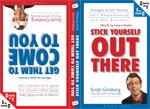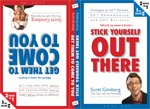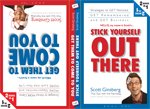 “How do people feel about using your system?”
“How do people feel about using your system?”
That’s the question that matters.
Whether you write software, own a retail store, run a non-profit, counsel married couples – even if you’re trying to land a job in a down economy – everyone has users.
Everyone. Even if you don’t call them users.
And if you can’t deliver your value with an abundance of user friendliness, you lose.
HERE’S THE REALITY: We live in an experience economy, a commoditized marketplace and hyperspeed culture.
That means people are no longer satisfied with good, fast and cheap – they want it perfect, now and free.
Today we’re going to explore a list of ways to make yourself, your brand and your service more user-friendly:1. You aren’t your customer. It doesn’t matter if you like it – it matters if users get it right away. It doesn’t matter if you think it’s cool – it matters if users enjoy using it. And it doesn’t matter if you get excited about it – it matters if users tell their friends about their positive, friendly experience of using it.
My suggestion: Stop superimposing onto your users what you think they should want. You may as well be winking in the dark. Instead, just ask people what they need. I’m sure they’d be happy to tell you. Like Jerry Maguire, learn to say, “Help me help you use me.”
Without solicitation of user feedback, you end up sitting in an office having a love affair with your own marketing. And the intangible asset known as your brand decreases in equity with every transaction. How have you made it easier for people to interact with you?
2. Never underestimate the profitability of findability. If they can’t find you, they can’t use you; and if they can’t use you, it won’t matter how friendly you are: Visitors will leave before they get a chance to become customers.
Peter Morville is the father of findability. He first defined the term in 2005 in his book Ambient Findability, as “The ability of users to identify an appropriate website and navigate the pages of the site to discover and retrieve relevant information resources.”
Ease and comfort. That’s the secret. Relevancy and realness. That’s the next secret. And demonstrating to users that you’re worth being found. That’s the final secret.
Then, the only thing issue left to consider is: “What happens after users find you?” Because what your users experience isn’t as important as the friendliness with which they experience it. Findability enables approachability. How findable are you?
3. Respond to the idiosyncratic needs of each user. If you force everyone to conform to the same style, you run the risk of losing people who matter. Instead, position your offerings in ways that make it easy for all types to access you.
For example, I recently made two changes to my accessibility options by offering users a menu of mediums. First, I changed my cell phone voicemail to say, “Here are the three ways to get in touch with me the quickest: Leave a message, send a text to this number, or email [email protected].”
The second change was made to the contact page of my website, which reads, “Everybody communicates differently. I am available and at your service and via whatever channel you prefer to use the most: Phone. Text. Email. Instant Message. Skype. Twitter. Facebook. Face to face.”
Remember: It’s not that users don’t like you – it’s that you’re not speaking on their frequency. If you want your message to be heard in a friendlier way, you have to also consider how people hear. Are you customizable?
4. Preserve people’s sense of control. In the psychology manual, The Handbook of Competence and Motivation, the research proved that human beings operate out of a model to feel autonomous and in control of their environment and actions.
Thus: The feeling of being in control is a basic human need. And your challenge is to make sure your users don’t lose that feeling.
For example, at the beginning of my presentations, I give my audience members my cell phone number. And I tell them that if they have any questions, comments or feedback, to text me. Then, time allowing, I’ll address as many of them as I can.
This approach wins for three reasons. First, it’s a cool way to interact with audience members, aka users. Secondly, by introducing anonymity, it creates an askable environment that makes people feel comfortable speaking up. Finally, the option of texting allows users to offer feedback at their own pace.
Ultimately, these three things reinforce people’s sense of control over the direction of the discussion. How will you do the same?
Remember: The two things that matter are how people experience you; and how people experience themselves in relation to you. And if “in control’ isn’t part of that equation, the only people who win are your competitors. How do you keep the ball in your user’s court?
5. Pamper people’s memories. If there’s one thing I’ve learned from wearing a nametag twenty-four seven for the past ten years, it’s that most people suck at remembering. Not just names, but everything. Partly because they don’t pay attention. Partly because they don’t write everything down. And partly because human memory is a mysterious beast.
The point is, if something as simple as a nametag can increase interpersonal friendliness, consider how you might pamper people’s memories within your user experience.
For example, the human memory can handle about seven bits of information at a time. Do everything you can to accommodate that capacity. Make it easy for people to organize and remember material.
The friendliness of their user experience will skyrocket. Even if they don’t realize it. Do your users’ brains love you?
6. Boring is bankruptcy. A friend of mine recently purchased an online sales training course for his employees. When I asked him why his salespeople liked the program so much, his answer surprised me: “Because it’s fun,” Don said. “Look, we can get good content anywhere. But the personality of this program is what makes it so cool.”
Lesson learned: Nobody buys boring, nobody notices normal and nobody pays for average. As my friend Rohit so eloquently suggested in his must-read book, Personality Not Included, “People don’t sue doctors they like.”
Your challenge is to figure out which unique attribute of your personality, life experience and expertise you can leverage in a remarkable way. That means: Values before vocation, individuality before industry and personality before profession.
After all, people buy people first. How are you leading with your person and following with your profession?
7. Reward people for making mistakes. User errors happen. Every day. My suggestion: Acknowledge them. Affirm them. Reward them. Correct them. And do it in a fun, brand-consistent, unexpected way. This humanizes people’s mistakes and makes for a more user-friendly experience.
Speaking of my website, the error page is my favorite. It’s a picture of me with a giant, broken nametag crushed over my head. And the text reads:
“Whoops. The page you were looking for no longer exists. Try searching Scott’s brain using the form to your right!”
You can view this at www.hellomynameisscott.com/error. It’s playful and relaxing, makes the mundane memorable and rewards users with an exclusive message when they make a mistake. Twitter popularized this same concept with their whale/bird graphic, which, in and of itself, became a powerful word of mouth marketing too. When your users screw up, how do you positively respond?
8. Uniformity is beauty. After wearing a nametag twenty-four seven for the past ten years – and then, somehow making a career out of that – I’ve learned that consistency is far better than rare moments of greatness. First, consistency between: Your actions and your attitude. That’s what enables your users to listen to you.
Second, consistency between: Your choices and your core. Your decisions and your dominant reality. Your message and your mentality. That’s what enables users to trust in you. Third, consistency between: Your practices and your principles. Your projects and your philosophies. Your vocation and your values. That’s what inspires users to follow after you.
And finally, consistency between: Your ventures and your visions. Your situations and your strengths. Your terminology and your truth. That’s what impels users to talk about you.
If you want to achieve the beauty of uniformity, write the following question on a sticky note and look at it daily: Is how you’re behaving right now consistent with the user-friendly experience you strive to provide?
REMEMBER: Everyone has users. Everyone.
And because people buy people first, the organizations that win are the ones who make the collective experience of their users friendlier.
LET ME ASK YA THIS…
What’s the nametag of your service process?
LET ME SUGGEST THIS…
For the list called, “12 Ways to Out Service the Competition,” send an email to me, and you win the list for free!
Scott Ginsberg
That Guy with the Nametag
Author, Speaker, Entrepreneur, Mentor
[email protected]
 Never the same speech twice.
Never the same speech twice.
Always about approachability.
Watch The Nametag Guy in action here!

 People use the Internet for one thing – and one thing only.
People use the Internet for one thing – and one thing only. “They don’t care if you’re good – they care if people come.”
“They don’t care if you’re good – they care if people come.” The Seven Dwarfs never had to deal with a recession.
The Seven Dwarfs never had to deal with a recession. The world’s FIRST two-in-one, flip-flop book!
The world’s FIRST two-in-one, flip-flop book! You can’t beat self-employment.
You can’t beat self-employment. “My life is my preparation.”
“My life is my preparation.” The world’s FIRST two-in-one, flip-flop book!
The world’s FIRST two-in-one, flip-flop book! And now for a few words from some dead white guys:
And now for a few words from some dead white guys: Six hours from now, I’ll be taking center stage here in Denver for the Optimist International Convention.
Six hours from now, I’ll be taking center stage here in Denver for the Optimist International Convention. The world’s FIRST two-in-one, flip-flop book!
The world’s FIRST two-in-one, flip-flop book! I’m aware of the irony of publishing a list of instructions on how not to conform.
I’m aware of the irony of publishing a list of instructions on how not to conform.